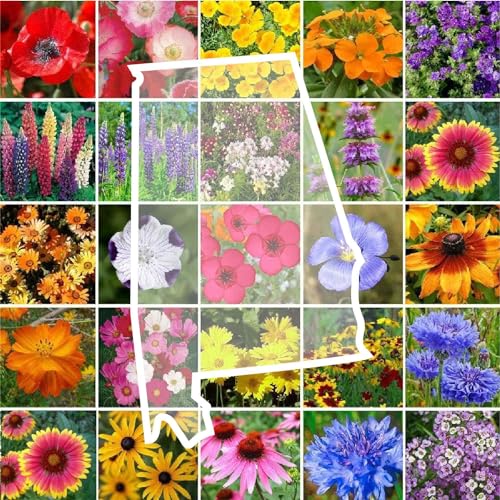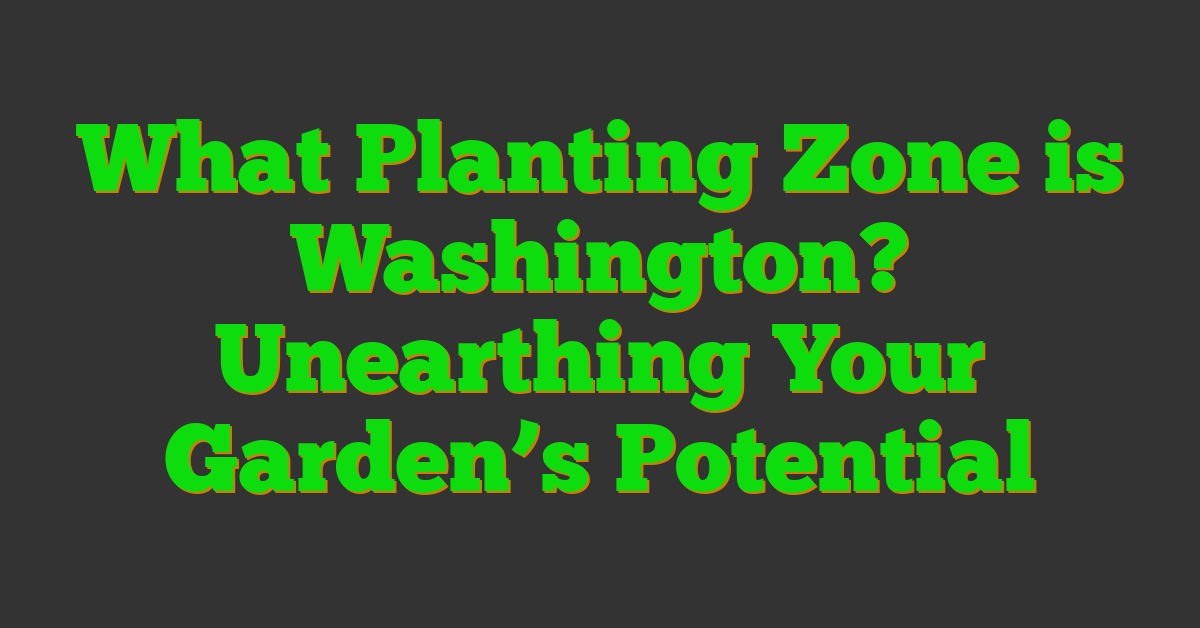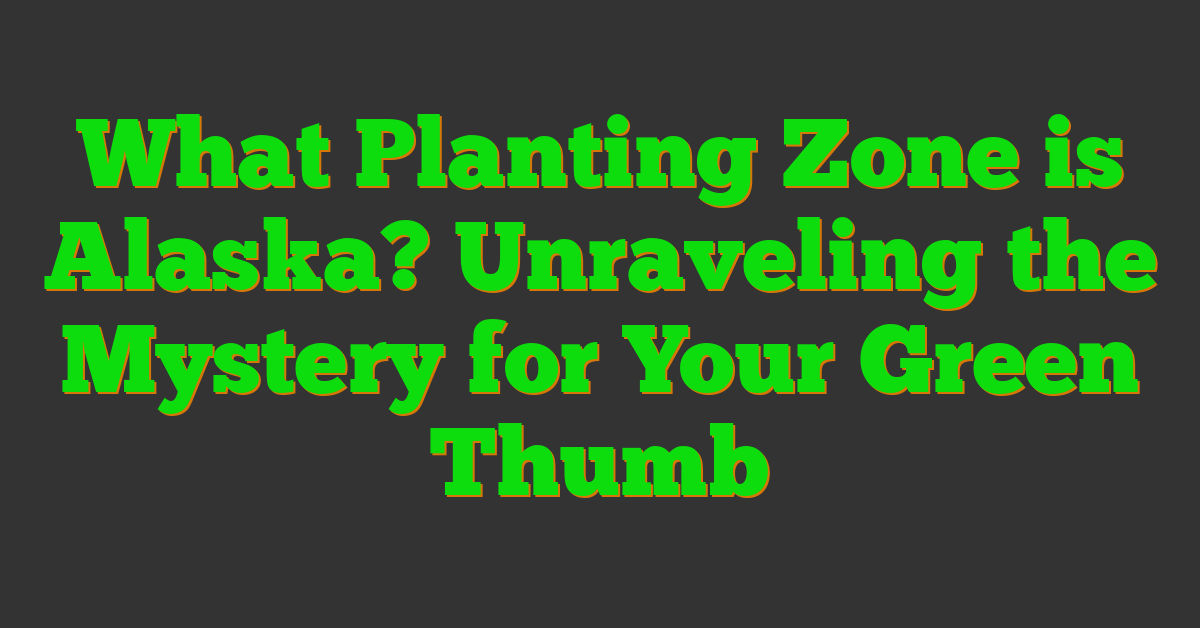Hey there, green thumb! You’re probably wondering, “What planting zone is Alabama?” Well, you’ve come to the right place for answers. Alabama’s unique geography means it spans a few different USDA Hardiness Zones. These zones are crucial for gardeners like yourself as they give you an idea of what plants will thrive in your area.

Most of Alabama falls within USDA Zones 7a to 8b. This means winter temperatures can go as low as 0-15 degrees Fahrenheit. That’s pretty chilly! But don’t worry – many plants love these conditions and will flourish beautifully in your Alabamian soil.
However, if you’re located down by the coast or in southernmost parts of the state, things heat up a bit more. Here you’ll find yourself in Zone 9a where lows just barely dip below freezing. So whether you’re planting tomatoes in Tuscaloosa or hydrangeas in Huntsville, knowing your zone is key! Understanding this not only helps your garden grow but also ensures that all those hours spent digging and sowing aren’t wasted on plants that simply won’t thrive in Alabama’s climate.
Understanding Planting Zones
Before you get those green thumbs to work, let’s talk planting zones. They’re like a cheat sheet for gardening success. These zones? They’re determined by the USDA and they help gardeners figure out which plants are most likely to thrive in their area.
So, how do these zones work exactly? Well, it’s all about temperature. Each zone represents an area of the United States where certain temperatures can be expected. The lower the number, the colder the zone; conversely, higher numbers equate to warmer climates.
- Zone 1: Below -50 F
- Zone 2: -50 to -40 F
- Zone 3: -40 to -30 F
- Zone 4: -30 to -20 F
- Zone 5: -20 to -10 F
- Zone 6: -10 to 0 F
- Zone 7: 0 to +10 F
- Zone 8: +10 to +20 F
- Zone 9:* +20 to +30F
Why does this matter? You might love hydrangeas but if you’re in Zone three where it gets pretty chilly, those beauties may not survive through winter! On the other hand, if you’re chilling (or rather sweltering) in Zone nine with some cool-loving spinach—it’s going grow faster than mold on cheese left out.
Now don’t worry if this is sounding complicated—it really isn’t! Once you’ve got your zone figured out (we’ll dive into Alabama’s soon), it becomes second nature because nurseries typically label plants with their appropriate zones. Before long, you’ll be selecting plants that feel right at home in your garden just like seasoned pros!
Alabama’s Climate and Geography
Diving into the heart of Alabama, you’ll quickly realize that it’s a state with an eclectic mix of climates and geographies. This Southern gem is known for its humid subtropical climate – meaning it gets to enjoy long, hot summers and mild winters. You’re looking at average summer temperatures soaring up to 90°F (32°C), while winter takes a softer approach with averages around 40°F (4°C). But what does this mean for your gardening endeavors? Well, it means you’ve got a pretty generous growing season on your hands!
Picture yourself standing in the midst of Alabama’s diverse geography. Rolling hills to your left, expansive plains stretching out to your right, and the Gulf Coast beckoning from afar. Yep, it’s as picturesque as it sounds! Now add pockets of forests, rivers snaking their way across the land, and soil types ranging from sandy coastal soils to limestone-based soils in the north – suddenly things get really exciting for plant enthusiasts like us.
One thing that might surprise you about Alabama is its position in multiple USDA Plant Hardiness Zones. It spans from zone 7a in the northern parts of the state all through zones 8a, 8b down southwards till zone 9a near the Gulf Coast. What this variety means is that Alabama can host a wide array of plants suited for these different zones.
| USDA Zone | Temperature Range |
|---|---|
| 7a | 0°F to 5°F |
| 8a | 10°F to 15°F |
| 8b | 15°F to 20°F |
| 9a | 20°F to25 °F |
Now let’s talk rainfall – ’cause trust me, there’s plenty! On average, Alabama receives about an impressive amount which ranges between approximately:
- 52 inches per year in the north,
- 56 inches per year in the central region, and
- a whopping 67 inches per year along the Gulf Coast.
That’s quite a bit of rain to keep your garden lush and thriving!
So there you have it. A quick snapshot of Alabama’s climate and geography from a landscaping perspective. Keep these factors in mind as you plan your planting strategies – they’ll certainly help make your gardening journey a whole lot more fruitful (and fun!). Stay tuned for more tips on how to harness Alabama’s unique conditions to create a garden that flourishes with life!
Overview of Alabama’s Planting Zone
So you’re a gardening enthusiast in Alabama, huh? Well, lucky for you, this southern state offers a unique blend of planting zones that cater to an extensive variety of plants. Now let’s dive into what this means for your green thumb.
First off, it might be helpful to take a quick peek at what planting zones are all about. Basically, they’re geographic areas defined by the USDA where specific types of plants can thrive due to the average annual minimum winter temperature. It’s like each plant has its own favorite vacation spot!
Alabama finds itself nestled between USDA hardiness zones 7a and 9a. This means winter temperatures can dip as low as 0 degrees Fahrenheit up north and stay relatively mild down south with lows around 20-25 degrees Fahrenheit. You’re dealing with quite the contrast here!
But hey, don’t let these numbers intimidate you! Here’s how they translate into your gardening life:
- Zone 7a: Covering northern parts of Alabama like Huntsville – you’ll find that deciduous fruit trees such as apples and peaches do well here.
- Zone 7b: Stretching through Birmingham into Montgomery – this zone favors ornamental trees like dogwoods and redbuds.
- Zone 8a/8b: Dominating central regions including Mobile – exotic fruits such as figs and citrus can be successfully grown here.
- Zone 9a: Limited to extreme southern parts near the Gulf Coast – subtropical species thrive in this zone.
There you have it! Understanding these planting zones is key in determining which plants will flourish in your backyard oasis or city balcony garden. Just remember not to get too caught up in sticking strictly to your designated zone – after all, nature loves to surprise us from time to time. So why not try pushing boundaries with some out-of-zone flora? Plants are more resilient than we often give them credit for. Happy planting!
How to Determine Your Specific Alabama Planting Zone
Planting in Alabama? You’re probably wondering which planting zone you fall into. Well, it’s not a one-size-fits-all answer and finding out your specific zone can be a bit tricky but no worries, we’ve got your back!
« What Planting Zone is Montana? Your Easy Guide to Understanding Gardening in Big Sky Country What Planting Zone is South Carolina? Discover Your Garden’s Potential! »
First off, let’s get familiar with the term “planting zones.” These are areas defined by the USDA Plant Hardiness Zone Map that categorize regions based on their average lowest winter temperature. In Alabama, you’re looking at zones 7a to 9a.
To find your precise zone, hop online and visit the USDA website. There you’ll find an interactive map where all you need to do is type in your zip code. Instantly, voila! You’ll discover exactly what zone you’re in.
- Zone 7a: This area covers northern parts of Alabama with temperatures plunging as low as zero to five degrees Fahrenheit.
- Zone 7b: Here it gets slightly warmer with temperatures dipping down between five and ten degrees Fahrenheit
- Zones 8a & 8b: Moving further south now – these zones experience milder winters reaching lows of ten to twenty degrees Fahrenheit.
- Zone 9a: Welcome to the southernmost tip of Alabama where winters are even more mild with minimum temps falling between twenty and twenty-five degrees Fahrenheit.
Knowing your specific zone is vital because each plant has its ideal growing conditions. So if you want those roses blooming or tomatoes ripe for picking come summer time, understanding this will give them the best chance for success.
Remember though, while hardiness zones provide a solid foundation for planning out your garden or landscape project they aren’t everything. Other factors such as soil condition, sunlight exposure and water availability also play significant roles in ensuring happy plants!
So there ya have it! With this information at hand, you’re well on your way towards becoming an Alabama-green-thumb. Happy planting, folks!
What Plants Thrive in Alabama’s Zone?
If you’re wondering about what plants do well in Alabama, you’re in the right place. With a planting zone that varies from 7a to 9a, this southern state offers a wide range of growing conditions for many plants.
Let’s start with flowers. Camellias are a real showstopper and they absolutely love it here! This evergreen shrub blooms through fall and winter giving your garden a splash of color when most other plants are dormant. Rhododendrons, Azaleas, and Hydrangeas also thrive in Alabama’s acidic soil.
Alabama is great for fruit trees too! Peach trees will yield an abundant harvest given the hot summers and mild winters this region experiences. Apples, Pears and Figs can also flourish here if cared for properly.
And who could forget vegetables? Tomatoes, okra, sweet potatoes – these sun-loving crops bask in Alabama’s long growing season. Peppers both sweet and spicy can be grown year-round with relative ease as well.
- Camellias: Fall & Winter Blooming
- Rhododendrons/Azaleas/Hydrangeas: Loves Acidic Soil
- Peach Trees: Abundant Harvests
- Apples/Pears/Figs: Can Flourish with Proper Care
- Tomatoes/Okra/Sweet Potatoes: Sun-Loving Crops
Of course, we aren’t forgetting the native species either! The Southern Magnolia Tree is not just symbolic but grows beautifully throughout Alabama too!
Last but not least let’s talk vines! Wisteria thrives so well here it’s considered invasive by some but managed carefully it can add stunning beauty to any landscape.
So there you have it folks—a peek into what makes gardening such a joyous pursuit in Alabama—whether you’re into flowers, fruits, veggies, or natives, there’s something for everyone in this planting zone!
Adjusting Gardening Strategies for Alabama’s Zone
Let’s dive in folks! If you’re a seasoned gardener or just getting your hands dirty, knowing the planting zone of your state is crucial. For those green thumbs situated in Alabama, you’re working with zones 7-9. What does that mean exactly? Well, it means you’ve got some unique opportunities – and challenges – when it comes to making things grow.
First off, understanding your specific zone (7a, 7b, 8a, 8b, or 9a) can be instrumental in selecting plants that’ll thrive in your garden. Let me paint a picture for ya: deciduous fruit trees like apples and pears do well across all these zones. But if you’re trying to cultivate something tropical like citrus or palm trees – stick to zones 8b and above where milder winters won’t damage these heat-lovers.
Now let’s talk timing! Planting seasons can vary from zone to zone too. In general though:
- Early spring is great for cool-season crops (think lettuce and spinach)
- Late spring/early summer welcomes warm-season crops (tomatoes and peppers anyone?)
- Fall rounds out the year with second plantings of cool-season goodies
Of course, there are exceptions but hey – gardening wouldn’t be fun without a little unpredictability!
Now if you thought we were done talking about temperature… think again! Hardiness isn’t only about surviving winter chills; it’s also about dealing with sweltering summers. Many plants wilt under Alabama’s intense heat so consider adding shade structures or mulch to protect them during the dog days of summer.
Don’t forget pests either – they love Alabama as much as your plants do! Regularly check your garden for insects and disease symptoms. Early detection could save your tomatoes from an untimely demise.
All this might sound daunting but trust me – understanding and leveraging your planting zone can turn you from a gardening hopeful into a veritable plant whisperer. So let’s get out there, get our hands dirty, and grow something beautiful! Alabama’s gardening zones are waiting for you to explore them!
Tips for Successful Gardening in Alabama’s Planting Zone
So, you’ve decided to roll up your sleeves and get dirty in the beautiful soil of Alabama’s planting zone. Well, you’re in luck! With its generally warm climate and generous rainfall, Alabama offers a fertile ground for green thumbs like yours. But here are some tips that’ll help you turn your garden into a blooming wonderland.
First things first, understanding the specific characteristics of Alabama’s planting zones is crucial. Most of the state falls under USDA Hardiness Zones 7b to 9a, which means plants can withstand temperatures as low as 5°F to 25°F. This range allows for a wide variety of plants to thrive including magnolias, hydrangeas, and tomatoes – all classic staples in an Alabamian garden.
Now let’s talk timing! To maximize your garden’s potential:
- Spring-planted veggies should hit the soil between February and April.
- For fall harvests aim for July through September plantings.
- Flowers? They’re happiest when planted from March through May.
You’re probably wondering about watering habits too right? In Alabama, Mother Nature provides plenty of rain but during those hotter summer months keep an eye on your greens. If it hasn’t rained within a week or if the top inch of soil is dry – it’s time to water!
And what about pests? You may encounter critters like Japanese beetles or aphids who fancy munching on your leafy greens. Don’t fret though – introducing natural predators like ladybugs or praying mantises can help control these pests without causing harm to your blossoming beauties.
Last but not least remember this golden rule: healthy soil equals healthy plants! Regularly adding organic matter such as compost or manure will enrich your soil and ultimately lead to more successful harvests.
There you have it folks – with these tips at hand, you’re well on your way to creating a thriving garden in the heart of Alabama’s planting zones. Now grab that trowel and let’s get planting!
Conclusion: Maximizing Garden Potential in Alabama
You’ve made it this far, and that means you’re ready to unlock all the potential your Alabama garden has to offer. Now that you know Alabama falls primarily within USDA hardiness zones 7a through 9a, you can confidently choose plants suited for these zones.
Let’s recap a few key points:
- Plants and trees should match the zone requirements of 7a-9a.
- Diverse weather conditions demand a flexible garden strategy.
- Native plants often thrive best.
Remember, successful gardening isn’t solely about picking the right plants. It also involves understanding how to care for them properly. Here’s where your landscape designer hat comes into play. You’ll need to consider factors like sunlight exposure, soil type and moisture levels in your area.
The good news is that Alabama’s climate accommodates a broad range of plants—from stunning flowering shrubs such as Azaleas and Hydrangeas, majestic trees like Southern Magnolia or Longleaf Pine, to edible delights including peaches and pecans. What an exciting plant pallette!
Gardening in Alabama can be immensely rewarding if done right. So go ahead, roll up those sleeves! Put on your green thumb and let’s make your garden flourish with life under the warm southern sun!











